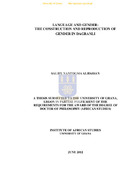UGSpace Repository
Language and Gender. The Construction and Reproduction of Gender in Dagbanli
- UGSpace Home
- →
- Theses
- →
- Doctoral
- →
- College of Humanities
- →
- Institute of African Studies
- →
- View Item
JavaScript is disabled for your browser. Some features of this site may not work without it.
| dc.contributor.advisor | Kropp-Dakubu, M.E. | |
| dc.contributor.advisor | Sutherland-Addy, E. | |
| dc.contributor.advisor | Akanlig-Pare, G. | |
| dc.contributor.author | Alhassan, S.N. | |
| dc.date.accessioned | 2014-07-23T15:51:20Z | |
| dc.date.accessioned | 2017-10-13T15:48:18Z | |
| dc.date.available | 2014-07-23T15:51:20Z | |
| dc.date.available | 2017-10-13T15:48:18Z | |
| dc.date.issued | 2012-06 | |
| dc.identifier.uri | http://197.255.68.203/handle/123456789/5191 | |
| dc.description | Thesis (PhD) - University of Ghana, 2012 | |
| dc.description.abstract | Gender is an issue of social and interpersonal relationships between males and females, a problem of differences in roles and values, and inequalities in opportunities, access to resources and power. These relationships, differences and inequalities are located in social and institutional structures and practices, but they are also firmly rooted in language. Language is a locus for the manifestation of gender because language and its usage convey not only factually objective meanings but also produce and reproduce social meanings and affect social relations. Using an eclectic conceptual framework, the study takes into consideration gender theories, feminist linguistic perspectives, and discourse analysis paradigms to critically examine Dagbanli linguistic items and Dagomba linguistic behaviour that create and re-affirm those culturally constructed differences and inequalities between males and females called gender. I examine single lexical items, phrases, proverbs, popular sayings as well as language in active everyday use in conjunction with the social and cultural circumstances that define usage practices or add gendered meanings to the language. These were collected from written texts and from language in active use recorded electronically and transcribed, or recorded in writing during conversations. The results show that the Dagomba hold strong views about differences between males and females and express these in various ways. Paired male/female or masculine /feminine linguistic items tend to have positive meanings for males but carry negative associations for females. There is a higher tendency of giving stereotypical and derogatory labels to females than to males. Negative representation of females is most pervasive in proverbs and contrasts sharply with positive representations of men, though the uniqueness of the woman as mother and wife is recognised. There are also some differences in the use of some linguistic items by males and females Men use forms that are associated with higher status and power while women have to use forms that are associated with inferior status. Men and women engaged in normal interaction routinely reproduce gender stereotypes as they use language. | en_US |
| dc.format.extent | xiii, 299p. | |
| dc.language.iso | en | en_US |
| dc.publisher | University of Ghana | en_US |
| dc.subject | Language | |
| dc.subject | Gender | |
| dc.subject | Linguistics | |
| dc.subject | Language Expression | |
| dc.subject | ||
| dc.title | Language and Gender. The Construction and Reproduction of Gender in Dagbanli | en_US |
| dc.type | Thesis | en_US |
| dc.rights.holder | University of Ghana |
